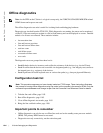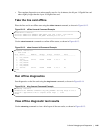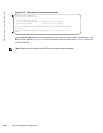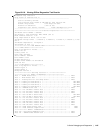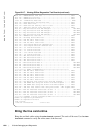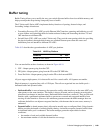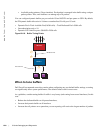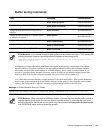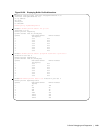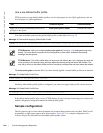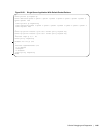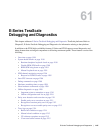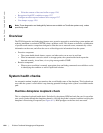
C-Series Debugging and Diagnostics | 1191
Buffer tuning commands
Configuration changes take effect immediately and appear in the running configuration. Since under
normal conditions all ports do not require the maximum possible allocation, the configured dynamic
allocations can exceed the actual amount of available memory; this is called oversubscription. If you
choose to oversubscribe the dynamic allocation, a burst of traffic on one interface might prevent other
interfaces from receiving the configured dynamic allocation, which causes packet loss.
You cannot allocate more than the available memory for the dedicated buffers. If the system determines
that the sum of the configured dedicated buffers allocated to the queues is more than the total available
memory, the configuration is rejected, returning a syslog message similar to the following.
Task Command Command Mode
Define a buffer profile for the FP queues.
buffer-profile fp fsqueue
CONFIGURATION
Define a buffer profile for the CSF queues.
buffer-profile csf csqueue
CONFIGURATION
Change the dedicated buffers on a physical 1G
interface.
buffer dedicated
BUFFER PROFILE
Change the maximum amount of dynamic buffers
an interface can request.
buffer dynamic
BUFFER PROFILE
Change the number of packet-pointers per queue.
buffer packet-pointers
BUFFER PROFILE
Apply the buffer profile to a line card.
buffer fp-uplink linecard
CONFIGURATION
Apply the buffer profile to a CSF to FP link.
buffer csf linecard
CONFIGURATION
FTOS Behavior: If you attempt to apply a buffer profile to a non-existent port-pipe, FTOS displays the
following message. However, the configuration still appears in the running-config.
%DIFFSERV-2-DSA_BUFF_CARVING_INVALID_PORT_SET: Invalid FP port-set 2 for linecard 2. Valid
range of port-set is <0-1>
Message 11 Buffer Allocation Error on C-Series
Mar 26 01:54:16: %E48VB:0 %DIFFSERV-2-DSA_DEVICE_BUFFER_UNAVAILABLE: Unable to allocate dedicated
buffers for linecard 0, port pipe 0, egress port 24 due to unavailability of cells
FTOS Behavior: When you move to a different chassis a line card that has a buffer profile applied at
interface level on the fp-uplink, the line card retains the buffer profile. To return the line card to the
default buffer profile, remove the current profile using the command no buffer-profile fp-uplink linecard
from INTERFACE mode, and then reload the chassis.




